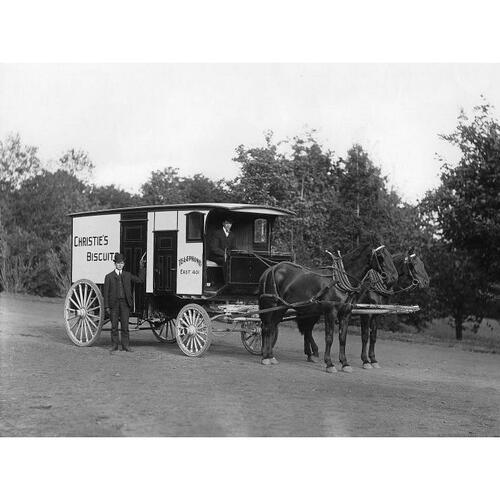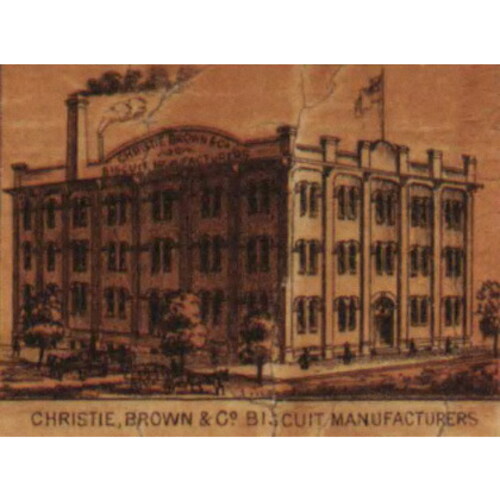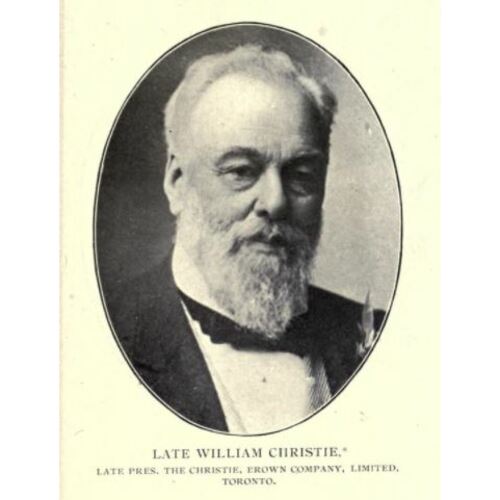
Source: Courtesy of Wikimedia Commons
CHRISTIE, WILLIAM MELLIS, baker and biscuit manufacturer; b. 5 Jan. 1829 in Huntly, Scotland, only child of John Christie and Jane Grant; m. 21 March 1855 Mary Jane McMullen, and four of their seven children survived into adulthood; d. 14 June 1900 in Toronto.
William Mellis Christie received a parish-school education at Forglen (about 30 miles from his birthplace) and was apprenticed to a baker in neighbouring Turriff in November 1843, at the age of 14. He completed his training in 1847 and, judging Scotland’s economic prospects too limited, emigrated to Canada the following year. In September 1848 he began working as a baker in Toronto for William McConnell. The shop was located on Yonge Street at the north limit of the city and, for four dollars a month plus board and lodging, Christie baked bread through the night and delivered it by handcart to customers in nearby Yorkville (Toronto). About 1850 he became an employee at the bakery of Alexander Mathers and Alexander Brown, also situated at the north end on Yonge Street. In 1853 he and George Maver took over the business. Christie suffered financial reverses in 1854 but by 1856 had recovered sufficiently to buy out his partner, purchase the shop, and hire three assistants.
He began to acquire a reputation for biscuit-making in 1858 when, at the exhibition in Toronto of the Agricultural Association of Upper Canada, he was awarded first prize for best collection of biscuits. In 1860 Christie formed a partnership with his father-in-law, James McMullen, and turned exclusively to biscuit-making. The six-man enterprise produced more than 4,300 boxes of biscuits by hand each year, worth some $13,000. About 1864 Christie began delivering primarily to the wholesale trade.
Rapidly increasing demand through the 1860s forced him to turn for capital to his former employer, Alexander Brown. The pair became partners in 1868 under the name Christie, Brown and Company and late that year installed steam-powered machinery at their expanded Yonge Street shop. By 1870 the work-force had doubled, to 12, and sales quadrupled. The factory was moved to the heart of the city in 1872 and, transferred to a nearby address in late 1874, the business grew to encompass an entire block at Duke (Adelaide) and Frederick streets. Christie bought out his partner in February 1878 and, retaining the name Christie, Brown and Company, remained sole owner until his death.
In 1876 Christie had travelled to the Philadelphia Centennial International Exhibition with samples of his biscuits and returned with silver and bronze medals. Illustrations of these awards were added to his packaging and the success of the venture encouraged trips to other international fairs to promote his product at home and abroad. The firm opened a sales office in Montreal in 1880, and in Toronto a staff of 120 in the mid 1880s grew to about 375 by the turn of the century. Christie had only one large biscuit-making competitor in Toronto in the last three decades of the 19th century, the confectionery of William Hessin, which he overtook in size in the 1870s. By 1890 in Toronto about one of every five workers in the baking industry, or about two out of three in biscuit manufacturing, was employed by Christie. From the late 1880s the firm was widely regarded as the largest such enterprise in Canada. By all accounts, Christie took a personal interest in maintaining quality in the company’s more than 400 varieties of cakes and biscuits. Deliveries were made to all parts of Canada, but exports appear to have been negligible before Christie’s death. For a number of years, however, the Toronto World noted in 1900, the English biscuit-making firm of Huntley and Palmers had had a “standing arrangement” with Christie “for the use of the many improvements” made by him “in the manufacture of biscuits. . . . Christie would experiment with a biscuit or a machine for weeks until he got the goods just as he wanted them in shape, flavor and appearance.” In June 1899 Christie, Brown and Company incorporated as a joint-stock company, with all 5,000 shares owned by Christie, a move partly designed to facilitate the disposal of his estate after his death.
Christie had lived in cramped quarters with his family and boarders above the frame shop on Yonge Street until 1870, when the firm’s prosperity brought a turn-about in his personal circumstances. After moves to increasingly larger and better appointed homes, he had a mansion built in Toronto’s exclusive Queen’s Park enclave and moved his family there in 1881. His phenomenal success also earned him a berth among Toronto’s business and political leaders, and he became a close acquaintance of fellow-Liberal Oliver Mowat*. In 1879 Christie helped found the Industrial Exhibition Association and for many years was chairman of its horse committee. He was a member of the council of Toronto’s Board of Trade from 1883 until his death, became a trustee of the University of Toronto in 1887, and joined the Canadian Manufacturers’ Association in 1891. In the last two decades of his life Christie indulged a passion for travel, visiting much of Canada, the United States, Britain, and Europe. He quietly made donations to charities and, apart from business and travel, his time was taken up in wide-ranging reading and tending to his garden. A man of few words, he was a staunch imperialist and a dutiful Presbyterian, and he remained sceptical of organized labour.
Christie revisited his birthplace in Scotland in the summer of 1899. Shortly after his return to Canada cancer appeared on his neck and spread rapidly. He died at his Queen’s Park home on 14 June 1900 and the business, worth $500,000, passed to his only son, Robert Jaffray Christie. The family sold the firm in the late 1920s and it continues as Christie, Brown and Company under the ownership of an American concern, Nabisco Brands Limited.
William Mellis Christie successfully bridged two eras in Canada’s economic evolution, changing from hand production in a small shop to steam-powered manufacture in a large enterprise with a division of labour. His insistence on quality and his mechanical aptitude ensured a marketable product and his flair for promotion made Christie a household name in his time.
AO, MU 2181, corr., 1898–99; MU 7728, no.1; RG 55, partnership records, York County, Toronto, nos.235, 1703. CTA, RG 1, A, 19, 26 Oct. 1868; 29 July 1872; 19 Aug. 1874; RG 5, F, 1848–71. NA, RG 31, C1, 1861, 1871, Toronto. Private arch., Helen Christie (Toronto), Christie family papers and letters. York County Surrogate Court (Toronto), no.14104 (mfm. at AO). Canadian Grocer (Toronto), 22 June 1900. Canadian Manufacturer (Toronto), 3 Aug. 1888: 76. W. F. M[unro], Diary of the Christie party’s trip to the Pacific coast (Toronto, [1897]; 2nd ed., [1897]). Daily Mail and Empire, 15 June 1900. Evening Telegram (Toronto), 14 June 1900. Globe, 5 April 1893, 15 June 1900. Toronto Daily Star, 14 June 1900. Toronto World, 15 June 1900. Commemorative biog. record, county York, 47–48. Cyclopædia of Canadian biog. (Rose and Charlesworth), vol.1. Toronto directory, 1850–73. Hist. of Toronto, 1: 376–77. Illustrated Toronto, past and present, being an historical and descriptive guide-book . . . , comp. J. Timperlake (Toronto, 1877), 276–78. Industries of Canada: historical and commercial sketches of Toronto and environs . . . (Toronto, 1886), 199. Special number of the “Dominion Illustrated” devoted to Toronto, the commercial metropolis of Ontario (Montreal, 1892), 53. Toronto, Board of Trade, “Souvenir”, 184. Globe, 14 June 1926.
Cite This Article
Dean Beeby, “CHRISTIE, WILLIAM MELLIS,” in Dictionary of Canadian Biography, vol. 12, University of Toronto/Université Laval, 2003–, accessed March 29, 2025, https://www.biographi.ca/en/bio/christie_william_mellis_12E.html.
The citation above shows the format for footnotes and endnotes according to the Chicago manual of style (16th edition). Information to be used in other citation formats:
| Permalink: | https://www.biographi.ca/en/bio/christie_william_mellis_12E.html |
| Author of Article: | Dean Beeby |
| Title of Article: | CHRISTIE, WILLIAM MELLIS |
| Publication Name: | Dictionary of Canadian Biography, vol. 12 |
| Publisher: | University of Toronto/Université Laval |
| Year of revision: | 1990 |
| Access Date: | March 29, 2025 |





